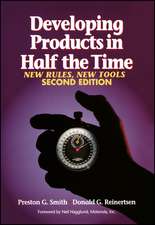Six Sigma and the Product Development Cycle
Autor Graham Wilsonen Limba Engleză Paperback – 15 iun 2005
One of the key issues facing businesses today is how to eliminate the high cost of developing new products. This is an area where the potential of six sigma has not been widely appreciated before.
Six Sigma and the Product Development Cycle brings the six sigma approach up-to-date and explains it in a way that appeals to today’s management teams. It makes the concept of six sigma easy to understand and accessible with the statistics necessary for its implementation clearly explained.
Six Sigma and the Product Development Cycle covers the integration of quality function deployment with Taguchi’s methods of experimental design and statistical process control. These tools gather detailed insights into customer needs, optimize the products or services to meet these needs at the lowest practical cost, and ensure that this performance is maintained. It is a book about both six sigma and product and service development. Through this approach an organization can gain greater flexibility, shorter timescales, and the ability to react more quickly to changes or new demands in the marketplace. The approach is illustrated with practical examples from the nuclear industry, motor manufacturing, inland mail, ‘emergency response’ organizations and financial services.
Preț: 461.30 lei
Preț vechi: 542.70 lei
-15% Nou
Puncte Express: 692
Preț estimativ în valută:
88.28€ • 95.86$ • 74.16£
88.28€ • 95.86$ • 74.16£
Carte tipărită la comandă
Livrare economică 22 aprilie-06 mai
Preluare comenzi: 021 569.72.76
Specificații
ISBN-13: 9780750662185
ISBN-10: 0750662182
Pagini: 244
Dimensiuni: 156 x 234 x 19 mm
Greutate: 0.46 kg
Ediția:1
Editura: Taylor & Francis
Colecția Routledge
Locul publicării:Oxford, United Kingdom
ISBN-10: 0750662182
Pagini: 244
Dimensiuni: 156 x 234 x 19 mm
Greutate: 0.46 kg
Ediția:1
Editura: Taylor & Francis
Colecția Routledge
Locul publicării:Oxford, United Kingdom
Public țintă
Professional Practice & DevelopmentCuprins
Chapter 1 Culture; Chapter 2 What is six sigma?; Chapter 3 The transformation that is six sigma; Chapter 4 The product development cycle; Chapter 5 Quality function deployment; Chapter 6 Taguchi's techniques; Chapter 7 Statistical process control;
Descriere
Six sigma is an effective and important management approach particularly used by multinational companies with manufacturing bases in the Asian and Pacific rim.
One of the key issues facing businesses today is how to eliminate the high cost of developing new products. This is an area where the potential of six sigma has not been widely appreciated before.
Six Sigma and the Product Development Cycle brings the six sigma approach up-to-date and explains it in a way that appeals to today’s management teams. It makes the concept of six sigma easy to understand and accessible with the statistics necessary for its implementation clearly explained.
Six Sigma and the Product Development Cycle covers the integration of quality function deployment with Taguchi’s methods of experimental design and statistical process control. These tools gather detailed insights into customer needs, optimize the products or services to meet these needs at the lowest practical cost, and ensure that this performance is maintained. It is a book about both six sigma and product and service development. Through this approach an organization can gain greater flexibility, shorter timescales, and the ability to react more quickly to changes or new demands in the marketplace. The approach is illustrated with practical examples from the nuclear industry, motor manufacturing, inland mail, ‘emergency response’ organizations and financial services.
One of the key issues facing businesses today is how to eliminate the high cost of developing new products. This is an area where the potential of six sigma has not been widely appreciated before.
Six Sigma and the Product Development Cycle brings the six sigma approach up-to-date and explains it in a way that appeals to today’s management teams. It makes the concept of six sigma easy to understand and accessible with the statistics necessary for its implementation clearly explained.
Six Sigma and the Product Development Cycle covers the integration of quality function deployment with Taguchi’s methods of experimental design and statistical process control. These tools gather detailed insights into customer needs, optimize the products or services to meet these needs at the lowest practical cost, and ensure that this performance is maintained. It is a book about both six sigma and product and service development. Through this approach an organization can gain greater flexibility, shorter timescales, and the ability to react more quickly to changes or new demands in the marketplace. The approach is illustrated with practical examples from the nuclear industry, motor manufacturing, inland mail, ‘emergency response’ organizations and financial services.












